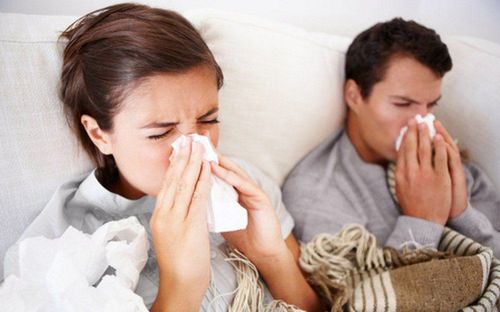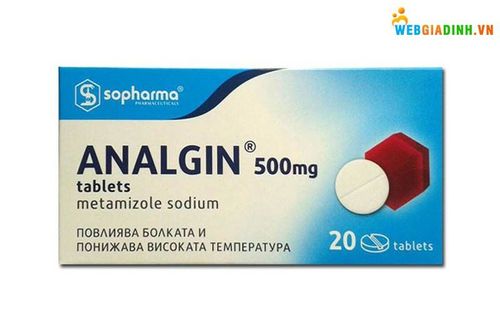This is an automatically translated article.
Coldacmin Flu on the market is very popular because of its affordable price and very effective effect in pain relief and fever reduction. So what is Coldacmin Flu? What is Coldacmin Flu used for? What is the correct way to drink? What points should be considered and noted when taking this drug? The following article will help you better understand the notes when using Coldacmin Flu.
1. What are the uses of Coldacmin Flu?
1.1. What is Coldacmin Flu? Coldacmin Flu belongs to the group of cough and cold medicines, with registration number VD-24597-16, by Hau Giang Pharmaceutical Joint Stock Company - one of the leading companies in the pharmaceutical field.
Coldacmin Flu medicine includes the following ingredients:
Main active ingredients: Paracetamol 325mg, Chlorpheniramine maleate 2mg. Excipients: Wheat starch, PVA, white sugar, tartrazine yellow, erythrosin red. The drug is produced in the form of hard capsules with many yellow - red seeds, blisters of 10 tablets, boxes of 10 blisters.
Coldacmin Flu is recommended for use in children 6 years of age and older and adults.
1.2. What is Coldacmin Flu used for? Paracetamol is an analgesic - antipyretic. The drug acts on the hypothalamic heat-regulating center causing hypothermia, increased heat loss due to vasodilation, and increased peripheral blood flow, reducing body temperature in febrile individuals, but rarely in normal subjects. Paracetamol relieves pain by raising the pain threshold.
Chlorpheniramine maleate is an antihistamine that reduces edema and urticaria in hypersensitivity reactions such as allergies and anaphylaxis.
Coldacmin Flu is used without prescription in the following cases: Symptomatic treatment of cases: Fever, headache, muscle and joint pain accompanied by nasal congestion, runny nose, rhinitis, inflammation mucous membrane secretions, sinusitis due to flu or allergies to the weather.
2. How to use Coldacmin Flu
2.1. How to take Coldacmin Flu Every 4-6 hours take 1 time. Take the medicine with a glass of water. Do not break, chew or crush, but swallow the whole tablet. Do not mix the drug with any other mixture. Read the user manual carefully before use. 2.2. Dosage of Coldacmin Flu Adults and children over 12 years old: Take 1-2 tablets/time. Children from 6 to 12 years old: Take half the adult dose or use as directed by a physician. Handling missed dose:
Add dose as soon as you remember. However, if the interval between the next dose is too short, skip the missed dose and resume the dosing schedule. Do not take a double dose to make up for a missed dose.
Treatment of overdose:
Paracetamol overdose due to a single toxic dose or repeated large doses of Paracetamol (7.5 - 10g per day, for 1-2 days) or long-term drug use. Dose-dependent hepatic necrosis is the most serious acute toxic effect of overdose and can be fatal.
Manifestations of Paracetamol overdose: Nausea, vomiting, abdominal pain, cyanosis of the skin, mucous membranes and nails.
Treatment: When intoxication with Paracetamol is severe, active supportive treatment is required. Gastric lavage in all cases, preferably within 4 hours after ingestion.
The main detoxification therapy is the use of Sulfhydryl compounds. N - acetylcysteine is effective when taken orally or intravenously. The medicine must be given immediately if it has not been 36 hours since taking Paracetamol. Treatment with N - acetylcysteine is more effective when the drug is given less than 10 hours after taking Paracetamol. When giving orally, dilute the N - acetylcysteine solution with water or a non-alcoholic beverage to obtain a 5% solution and must be drunk within 1 hour after mixing. Give oral N - acetylcysteine with the first dose of 140 mg/kg body weight, then give another 17 doses, each dose of 70 mg/kg body weight every 4 hours.
Alternatively, Methionine, activated charcoal and/or salt bleach can be used.
Chlorpheniramine overdose: psychotic manifestations, seizures, respiratory arrest, convulsions, anticholinergic effects,...
Treatment:
Gastric lavage or induce vomiting with syrup Ipecacuanha. Then, use activated charcoal or bleach to limit absorption. When hypotension and arrhythmias occur, it should be treated aggressively. Seizures can be treated with intravenous Diazepam or Phenytoin. Blood transfusions may be required in severe cases.
3. Contraindications of Coldacmin Flu
Patients who are allergic to the main active ingredient Paracetamol, Chlorpheniramine or any of the excipients listed above of Coldacmin Flu The patient has a glucose - 6 - phosphate dehydrogenase deficiency. The patient is in an acute asthma attack, has narrow-angle glaucoma, narrow peptic ulcer, pyloroduodenal obstruction, prostatic hypertrophy, bladder neck obstruction, the patient has taken MAO inhibitors within 14 days or more. come here. Women who are breastfeeding, infants and premature babies.
4. Notes when using Coldacmin Flu:
Paracetamol is not toxic at a relative therapeutic dose. However, occasional skin reactions including urticaria and maculopapular rash have been reported; Other hypersensitivity reactions include angioedema, laryngeal edema, and anaphylactoid reactions but are rare. Neutropenia and thrombocytopenic purpura have been reported with paracetamol use. More rarely, agranulocytosis.
For people with phenylketonuria and people who have to limit the amount of phenylalanine put into the body should avoid taking Paracetamol with drugs or foods containing Aspartame. For some people with hypersensitivity (asthma) should avoid taking Paracetamol with medicine or food containing sulfites. Should be used with caution in patients with pre-existing anemia, impaired liver and kidney function. Excessive alcohol consumption can increase the hepatotoxicity of Paracetamol, so avoid or limit alcohol consumption.
Chlorpheniramine may increase the risk of urinary retention, especially in patients with prostatic hypertrophy, urinary tract obstruction, pyloric obstruction, and exacerbation in patients with myasthenia gravis. The sedative effect of Chlorpheniramine is increased with alcohol intake and when used concomitantly with other sedatives. Caution when used for people with chronic lung disease, shortness of breath or difficulty breathing, people with glaucoma, the elderly. Risk of tooth decay when used for a long time.
For drugs containing Paracetamol: Physicians should warn patients about signs of serious skin reactions such as Steven-Johnson syndrome (SJS), toxic skin necrosis syndrome (TEN) or Lyell's syndrome, acute generalized exanthematous pustulosis (AGEP).
The drug may affect the ability to drive and use machines.
Use Coldacmin Flu only when absolutely necessary. Taking Chlorpheniramine during the third trimester of pregnancy can lead to serious reactions (such as seizures) in the newborn.
Do not use Coldacmin Flu with the following drugs:
Anticoagulants Coumarin and derivatives Indandion, Phenothiazines. Anticonvulsants (Phenytoin, Barbiturates, Carbamazepine), Isoniazid, sedatives. Wine and other alcoholic beverages. Monoamine oxidase inhibitors.
5. Coldacmin Flu side effects
When using Coldacmin Flu, you may experience undesirable effects (ADRs) such as:
Allergic reactions, vomiting, nausea, rash, neutropenia, thrombocytopenia and pancytopenia bridge. May cause liver failure (due to destruction of liver cells) when taking high doses of Paracetamol for a long time. Dry mouth, dysregulation, urinary retention, sweating, somnolence, sedation.
6. How to store Coldacmin Flu
Store in a cool, dry place, at a temperature not exceeding 30°C, in the original packaging and protected from light. Keep out of reach of CHILDREN.
Please dial HOTLINE for more information or register for an appointment HERE. Download MyVinmec app to make appointments faster and to manage your bookings easily.













